Note
Click here to download the full example code
Speech Enhancement with MVDR Beamforming¶
Author: Zhaoheng Ni
1. Overview¶
This is a tutorial on applying Minimum Variance Distortionless Response (MVDR) beamforming to estimate enhanced speech with TorchAudio.
Steps:
Generate an ideal ratio mask (IRM) by dividing the clean/noise magnitude by the mixture magnitude.
Estimate power spectral density (PSD) matrices using
torchaudio.transforms.PSD().Estimate enhanced speech using MVDR modules (
torchaudio.transforms.SoudenMVDR()andtorchaudio.transforms.RTFMVDR()).Benchmark the two methods (
torchaudio.functional.rtf_evd()andtorchaudio.functional.rtf_power()) for computing the relative transfer function (RTF) matrix of the reference microphone.
import torch
import torchaudio
import torchaudio.functional as F
print(torch.__version__)
print(torchaudio.__version__)
import matplotlib.pyplot as plt
from IPython.display import Audio
2.10.0.dev20251013+cu126
2.8.0a0+1d65bbe
2. Preparation¶
2.1. Import the packages
from torchaudio.utils import _download_asset
2.2. Download audio data¶
The multi-channel audio example is selected from ConferencingSpeech dataset.
The original filename is
SSB07200001\#noise-sound-bible-0038\#7.86_6.16_3.00_3.14_4.84_134.5285_191.7899_0.4735\#15217\#25.16333303751458\#0.2101221178590021.wav
which was generated with:
SSB07200001.wavfrom AISHELL-3 (Apache License v.2.0)noise-sound-bible-0038.wavfrom MUSAN (Attribution 4.0 International — CC BY 4.0)
SAMPLE_RATE = 16000
SAMPLE_CLEAN = _download_asset("tutorial-assets/mvdr/clean_speech.wav")
SAMPLE_NOISE = _download_asset("tutorial-assets/mvdr/noise.wav")
12.8%
25.6%
38.4%
51.2%
64.0%
76.8%
89.6%
100.0%
6.4%
12.8%
19.2%
25.6%
32.0%
38.4%
44.8%
51.2%
57.6%
64.0%
70.4%
76.8%
83.2%
89.6%
96.0%
100.0%
2.3. Helper functions¶
def plot_spectrogram(stft, title="Spectrogram"):
magnitude = stft.abs()
spectrogram = 20 * torch.log10(magnitude + 1e-8).numpy()
figure, axis = plt.subplots(1, 1)
img = axis.imshow(spectrogram, cmap="viridis", vmin=-100, vmax=0, origin="lower", aspect="auto")
axis.set_title(title)
plt.colorbar(img, ax=axis)
def plot_mask(mask, title="Mask"):
mask = mask.numpy()
figure, axis = plt.subplots(1, 1)
img = axis.imshow(mask, cmap="viridis", origin="lower", aspect="auto")
axis.set_title(title)
plt.colorbar(img, ax=axis)
def si_snr(estimate, reference, epsilon=1e-8):
estimate = estimate - estimate.mean()
reference = reference - reference.mean()
reference_pow = reference.pow(2).mean(axis=1, keepdim=True)
mix_pow = (estimate * reference).mean(axis=1, keepdim=True)
scale = mix_pow / (reference_pow + epsilon)
reference = scale * reference
error = estimate - reference
reference_pow = reference.pow(2)
error_pow = error.pow(2)
reference_pow = reference_pow.mean(axis=1)
error_pow = error_pow.mean(axis=1)
si_snr = 10 * torch.log10(reference_pow) - 10 * torch.log10(error_pow)
return si_snr.item()
def generate_mixture(waveform_clean, waveform_noise, target_snr):
power_clean_signal = waveform_clean.pow(2).mean()
power_noise_signal = waveform_noise.pow(2).mean()
current_snr = 10 * torch.log10(power_clean_signal / power_noise_signal)
waveform_noise *= 10 ** (-(target_snr - current_snr) / 20)
return waveform_clean + waveform_noise
# If you have mir_eval installed, you can use it to evaluate the separation quality of the estimated sources.
# You can also evaluate the intelligibility of the speech with the Short-Time Objective Intelligibility (STOI) metric
# available in the `pystoi` package, or the Perceptual Evaluation of Speech Quality (PESQ) metric available in the `pesq` package.
def evaluate(estimate, reference):
from pesq import pesq
from pystoi import stoi
import mir_eval
si_snr_score = si_snr(estimate, reference)
(
sdr,
_,
_,
_,
) = mir_eval.separation.bss_eval_sources(reference.numpy(), estimate.numpy(), False)
pesq_mix = pesq(SAMPLE_RATE, estimate[0].numpy(), reference[0].numpy(), "wb")
stoi_mix = stoi(reference[0].numpy(), estimate[0].numpy(), SAMPLE_RATE, extended=False)
print(f"SDR score: {sdr[0]}")
print(f"Si-SNR score: {si_snr_score}")
print(f"PESQ score: {pesq_mix}")
print(f"STOI score: {stoi_mix}")
3. Generate Ideal Ratio Masks (IRMs)¶
3.1. Load audio data¶
waveform_clean, sr = torchaudio.load(SAMPLE_CLEAN)
waveform_noise, sr2 = torchaudio.load(SAMPLE_NOISE)
assert sr == sr2 == SAMPLE_RATE
# The mixture waveform is a combination of clean and noise waveforms with a desired SNR.
target_snr = 3
waveform_mix = generate_mixture(waveform_clean, waveform_noise, target_snr)
Note: To improve computational robustness, it is recommended to represent
the waveforms as double-precision floating point (torch.float64 or torch.double) values.
3.2. Compute STFT coefficients¶
N_FFT = 1024
N_HOP = 256
stft = torchaudio.transforms.Spectrogram(
n_fft=N_FFT,
hop_length=N_HOP,
power=None,
)
istft = torchaudio.transforms.InverseSpectrogram(n_fft=N_FFT, hop_length=N_HOP)
stft_mix = stft(waveform_mix)
stft_clean = stft(waveform_clean)
stft_noise = stft(waveform_noise)
3.2.1. Visualize mixture speech¶
plot_spectrogram(stft_mix[0], "Spectrogram of Mixture Speech (dB)")
Audio(waveform_mix[0], rate=SAMPLE_RATE)
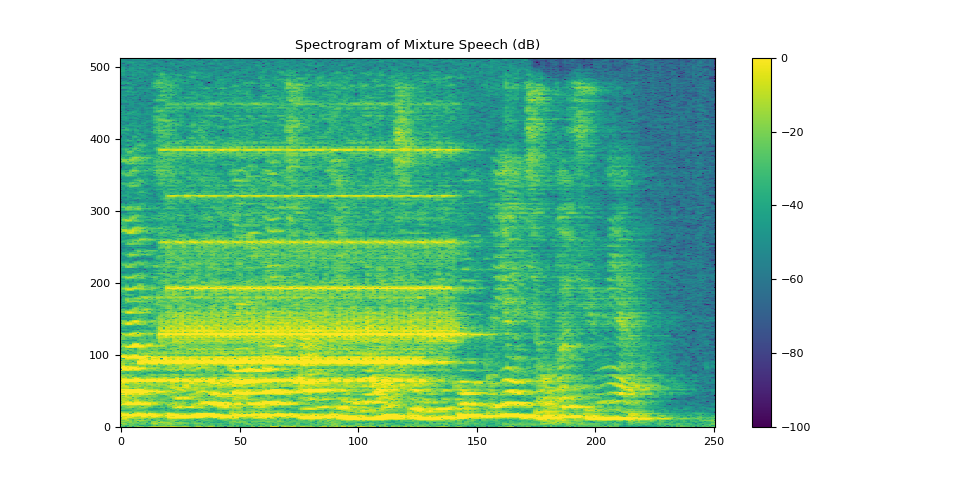
3.2.2. Visualize clean speech¶
plot_spectrogram(stft_clean[0], "Spectrogram of Clean Speech (dB)")
Audio(waveform_clean[0], rate=SAMPLE_RATE)
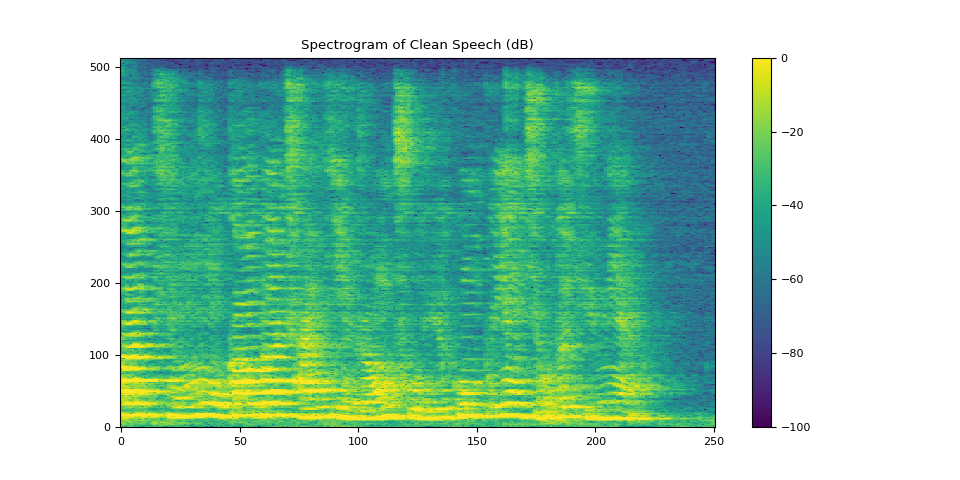
3.2.3. Visualize noise¶
plot_spectrogram(stft_noise[0], "Spectrogram of Noise (dB)")
Audio(waveform_noise[0], rate=SAMPLE_RATE)
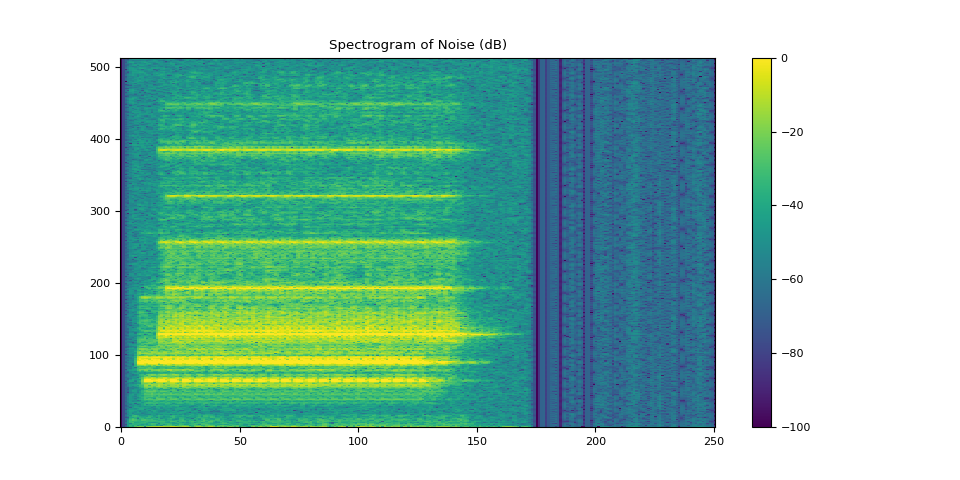
3.3. Define the reference microphone¶
We choose the first microphone in the array as the reference channel for demonstration. The selection of the reference channel may depend on the design of the microphone array.
You can also apply an end-to-end neural network which estimates both the reference channel and the PSD matrices, then obtains the enhanced STFT coefficients by the MVDR module.
3.4. Compute IRMs¶
def get_irms(stft_clean, stft_noise):
mag_clean = stft_clean.abs() ** 2
mag_noise = stft_noise.abs() ** 2
irm_speech = mag_clean / (mag_clean + mag_noise)
irm_noise = mag_noise / (mag_clean + mag_noise)
return irm_speech[REFERENCE_CHANNEL], irm_noise[REFERENCE_CHANNEL]
irm_speech, irm_noise = get_irms(stft_clean, stft_noise)
3.4.1. Visualize IRM of target speech¶
plot_mask(irm_speech, "IRM of the Target Speech")
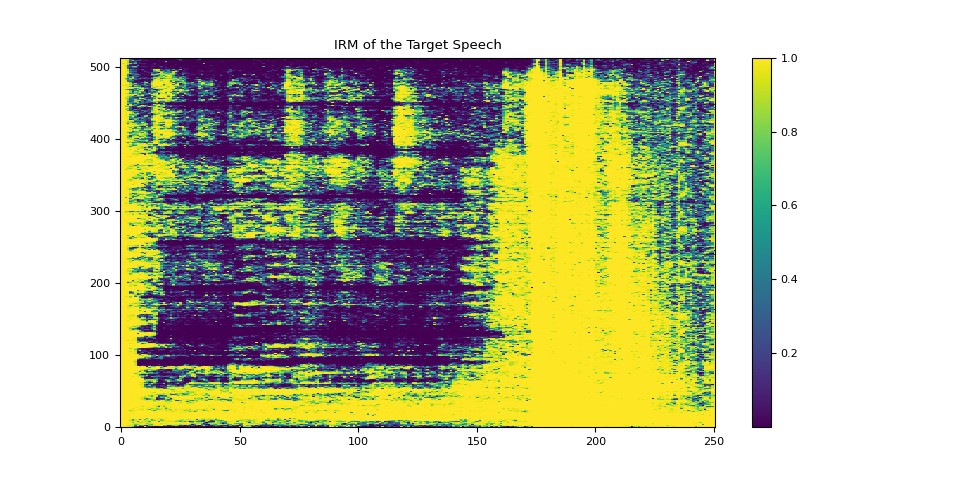
3.4.2. Visualize IRM of noise¶
plot_mask(irm_noise, "IRM of the Noise")
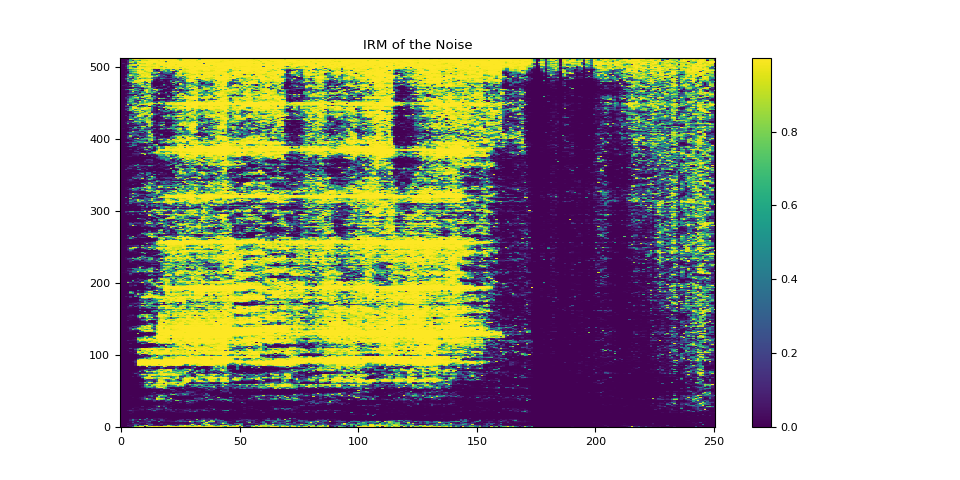
4. Compute PSD matrices¶
torchaudio.transforms.PSD() computes the time-invariant PSD matrix given
the multi-channel complex-valued STFT coefficients of the mixture speech
and the time-frequency mask.
The shape of the PSD matrix is (…, freq, channel, channel).
psd_transform = torchaudio.transforms.PSD()
psd_speech = psd_transform(stft_mix, irm_speech)
psd_noise = psd_transform(stft_mix, irm_noise)
5. Beamforming using SoudenMVDR¶
5.1. Apply beamforming¶
torchaudio.transforms.SoudenMVDR() takes the multi-channel
complexed-valued STFT coefficients of the mixture speech, PSD matrices of
target speech and noise, and the reference channel inputs.
The output is a single-channel complex-valued STFT coefficients of the enhanced speech.
We can then obtain the enhanced waveform by passing this output to the
torchaudio.transforms.InverseSpectrogram() module.
mvdr_transform = torchaudio.transforms.SoudenMVDR()
stft_souden = mvdr_transform(stft_mix, psd_speech, psd_noise, reference_channel=REFERENCE_CHANNEL)
waveform_souden = istft(stft_souden, length=waveform_mix.shape[-1])
5.2. Result for SoudenMVDR¶
plot_spectrogram(stft_souden, "Enhanced Spectrogram by SoudenMVDR (dB)")
waveform_souden = waveform_souden.reshape(1, -1)
Audio(waveform_souden, rate=SAMPLE_RATE)
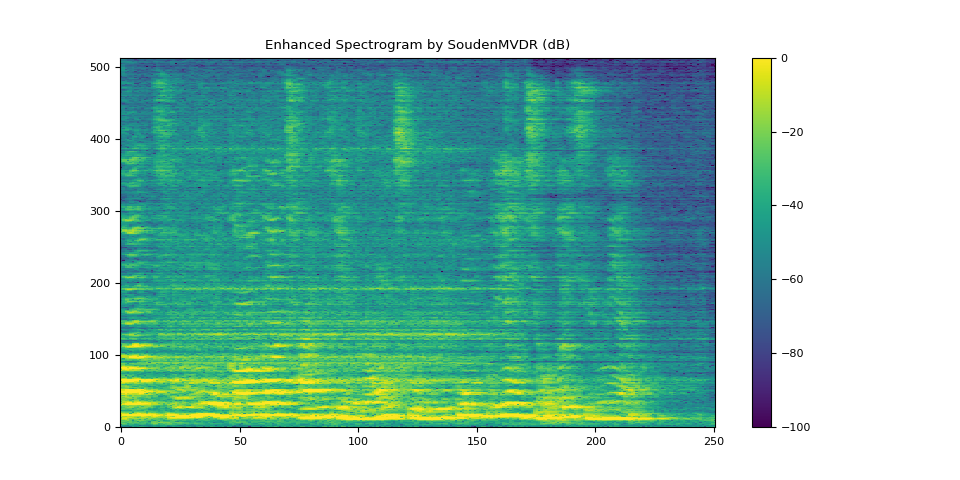
6. Beamforming using RTFMVDR¶
6.1. Compute RTF¶
TorchAudio offers two methods for computing the RTF matrix of a target speech:
torchaudio.functional.rtf_evd(), which applies eigenvalue decomposition to the PSD matrix of target speech to get the RTF matrix.torchaudio.functional.rtf_power(), which applies the power iteration method. You can specify the number of iterations with argumentn_iter.
rtf_evd = F.rtf_evd(psd_speech)
rtf_power = F.rtf_power(psd_speech, psd_noise, reference_channel=REFERENCE_CHANNEL)
6.2. Apply beamforming¶
torchaudio.transforms.RTFMVDR() takes the multi-channel
complexed-valued STFT coefficients of the mixture speech, RTF matrix of target speech,
PSD matrix of noise, and the reference channel inputs.
The output is a single-channel complex-valued STFT coefficients of the enhanced speech.
We can then obtain the enhanced waveform by passing this output to the
torchaudio.transforms.InverseSpectrogram() module.
mvdr_transform = torchaudio.transforms.RTFMVDR()
# compute the enhanced speech based on F.rtf_evd
stft_rtf_evd = mvdr_transform(stft_mix, rtf_evd, psd_noise, reference_channel=REFERENCE_CHANNEL)
waveform_rtf_evd = istft(stft_rtf_evd, length=waveform_mix.shape[-1])
# compute the enhanced speech based on F.rtf_power
stft_rtf_power = mvdr_transform(stft_mix, rtf_power, psd_noise, reference_channel=REFERENCE_CHANNEL)
waveform_rtf_power = istft(stft_rtf_power, length=waveform_mix.shape[-1])
6.3. Result for RTFMVDR with rtf_evd¶
plot_spectrogram(stft_rtf_evd, "Enhanced Spectrogram by RTFMVDR and F.rtf_evd (dB)")
waveform_rtf_evd = waveform_rtf_evd.reshape(1, -1)
Audio(waveform_rtf_evd, rate=SAMPLE_RATE)
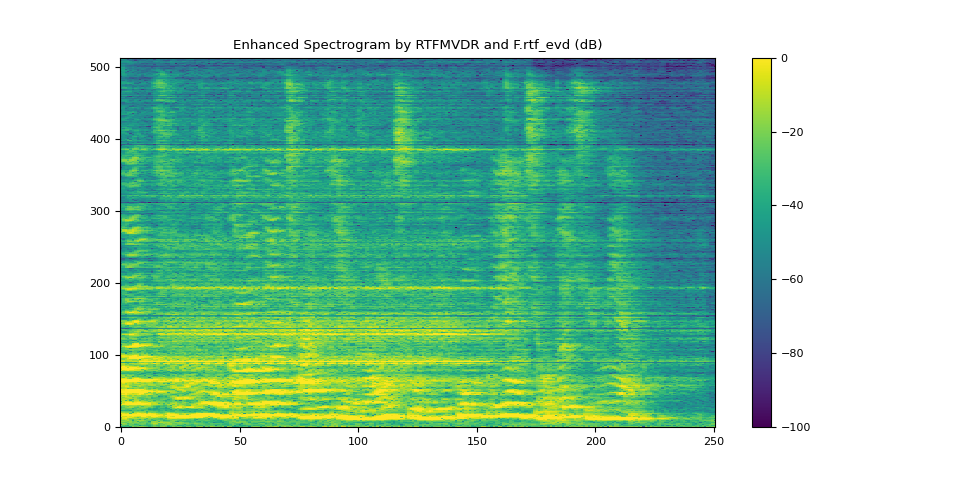
6.4. Result for RTFMVDR with rtf_power¶
plot_spectrogram(stft_rtf_power, "Enhanced Spectrogram by RTFMVDR and F.rtf_power (dB)")
waveform_rtf_power = waveform_rtf_power.reshape(1, -1)
Audio(waveform_rtf_power, rate=SAMPLE_RATE)
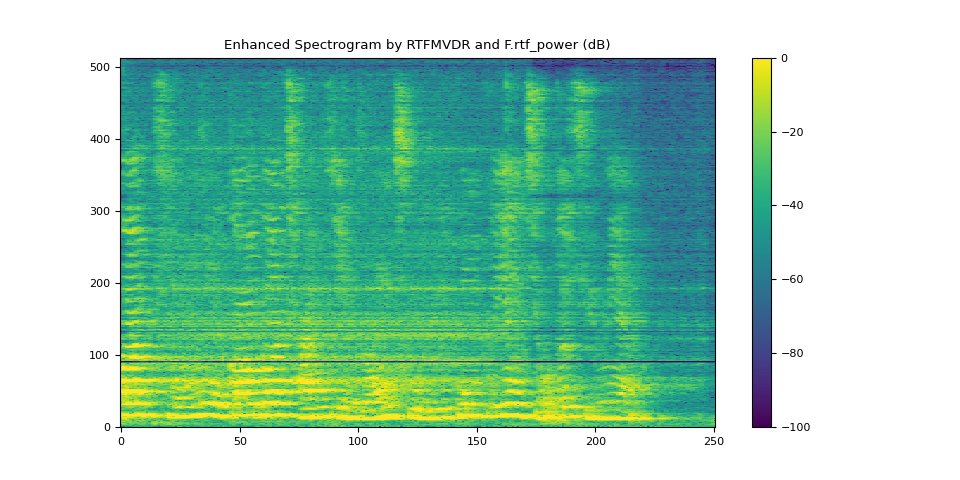
Total running time of the script: ( 0 minutes 1.653 seconds)



